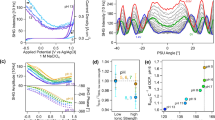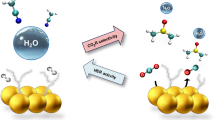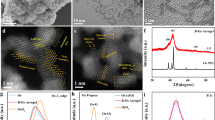Abstract
Electrification of many processes requires the use of aqueous solutions under mild pH conditions where the hydrogen evolution reaction (HER) and the oxygen evolution reaction (OER) can become competing reactions. The HER and OER under mild pH conditions show peculiar voltammetric behaviours, specifically two reductive or oxidative features, that are not observed in strongly acidic and basic solutions. These behaviours cannot be fully explained by thermodynamic considerations only and are particularly complex owing to the involvement of multiple water species (H3O+, H2O and OH–) and the conversion between these species via water autodissociation and acid–base neutralization reactions. This Analysis provides a systematic and conceptual explanation of the effect of pH, potential, stirring and buffer on the thermodynamics and kinetics of the HER and OER, providing fundamental and yet essential insights into comprehending HER and OER behaviours under mild pH conditions, and their implications for other aqueous reactions more broadly.

This is a preview of subscription content, access via your institution
Access options
Access Nature and 54 other Nature Portfolio journals
Get Nature+, our best-value online-access subscription
$32.99 / 30 days
cancel any time
Subscribe to this journal
Receive 12 digital issues and online access to articles
$119.00 per year
only $9.92 per issue
Buy this article
- Purchase on SpringerLink
- Instant access to full article PDF
Prices may be subject to local taxes which are calculated during checkout







Similar content being viewed by others
Data availability
The source data files for the plots contained in the current study are attached. Source data are provided with this paper.
References
Roger, I., Shipman, M. A. & Symes, M. D. Earth-abundant catalysts for electrochemical and photoelectrochemical water splitting. Nat. Rev. Chem. 1, 0003 (2017).
Cook, T. R. et al. Solar energy supply and storage for the legacy and nonlegacy worlds. Chem. Rev. 110, 6474–6502 (2010).
Li, X., Hao, X., Abudula, A. & Guan, G. Nanostructured catalysts for electrochemical water splitting: current state and prospects. J. Mater. Chem. A 4, 11973–12000 (2016).
Xia, R., Overa, S. & Jiao, F. Emerging electrochemical processes to decarbonize the chemical industry. JACS Au 2, 1054–1070 (2022).
Martín, A. J. & Pérez-Ramírez, J. Heading to distributed electrocatalytic conversion of small abundant molecules into fuels, chemicals, and fertilizers. Joule 3, 2602–2621 (2019).
Bender, M. T., Yuan, X., Goetz, M. K. & Choi, K. S. Electrochemical hydrogenation, hydrogenolysis, and dehydrogenation for reductive and oxidative biomass upgrading using 5-hydroxymethylfurfural as a model system. ACS Catal. 12, 12349–12368 (2022).
Nitopi, S. et al. Progress and perspectives of electrochemical CO2 reduction on copper in aqueous electrolyte. Chem. Rev. 119, 7610–7672 (2019).
Goetz, M. K., Bender, M. T. & Choi, K.-S. Predictive control of selective secondary alcohol oxidation of glycerol on NiOOH. Nat. Commun. 13, 5848 (2022).
Varela, A. S. et al. pH effects on the selectivity of the electrocatalytic CO2 reduction on graphene-embedded Fe–N–C motifs: bridging concepts between molecular homogeneous and solid-state heterogeneous catalysis. ACS Energy Lett. 3, 812–817 (2018).
Yuan, X., Lee, K., Eisenberg, J. B., Schmidt, J. R. & Choi, K.-S. Selective deoxygenation of biomass-derived carbonyl compounds on Zn via electrochemical Clemmensen reduction. Nat. Catal. 7, 43–54 (2024).
Wang, J. et al. Ambient ammonia synthesis via palladium-catalyzed electrohydrogenation of dinitrogen at low overpotential. Nat. Commun. 9, 1795 (2018).
Subbaraman, R. et al. Trends in activity for the water electrolyser reactions on 3d M(Ni,Co,Fe,Mn) hydr(oxy)oxide catalysts. Nat. Mater. 11, 550–557 (2012).
Strmcnik, D. et al. Improving the hydrogen oxidation reaction rate by promotion of hydroxyl adsorption. Nat. Chem. 5, 300–306 (2013).
Durst, J. et al. New insights into the electrochemical hydrogen oxidation and evolution reaction mechanism. Energy Environ. Sci. 7, 2255–2260 (2014).
Strmcnik, D., Lopes, P. P., Genorio, B., Stamenkovic, V. R. & Markovic, N. M. Design principles for hydrogen evolution reaction catalyst materials. Nano Energy 29, 29–36 (2016).
Lamoureux, P. S., Singh, A. R. & Chan, K. pH effects on hydrogen evolution and oxidation over Pt(111): insights from first-principles. ACS Catal. 9, 6194–6201 (2019).
Govindarajan, N., Xu, A. & Chan, K. How pH affects electrochemical processes. Science 375, 379–380 (2022).
Jung, O., Jackson, M. N., Bisbey, R. P., Kogan, N. E. & Surendranath, Y. Innocent buffers reveal the intrinsic pH- and coverage-dependent kinetics of the hydrogen evolution reaction on noble metals. Joule 6, 476–493 (2022).
McCrum, I. T. & Koper, M. T. M. The role of adsorbed hydroxide in hydrogen evolution reaction kinetics on modified platinum. Nat. Energy 5, 891–899 (2020).
Zhou, Z. et al. Electrocatalytic hydrogen evolution under neutral pH conditions: current understandings, recent advances, and future prospects. Energy Environ. Sci. 13, 3185–3206 (2020).
Liu, L., Liu, Y. & Liu, C. enhancing the understanding of hydrogen evolution and oxidation reactions on Pt(111) through ab initio simulation of electrode/electrolyte kinetics. J. Am. Chem. Soc. 142, 4985–4989 (2020).
Auinger, M. et al. Near-surface ion distribution and buffer effects during electrochemical reactions. Phys. Chem. Chem. Phys. 13, 16384–16394 (2011).
Grozovski, V., Vesztergom, S., Láng, G. G. & Broekmann, P. Electrochemical hydrogen evolution: H+ or H2O reduction? A rotating disk electrode study. J. Electrochem. Soc. 164, E3171–E3178 (2017).
Su, L. et al. Electric-double-layer origin of the kinetic pH effect of hydrogen electrocatalysis revealed by a universal hydroxide adsorption-dependent inflection-point behavior. J. Am. Chem. Soc. 145, 12051–12058 (2023).
Li, J., Stenlid, J. H., Ludwig, T., Lamoureux, P. S. & Abild-Pedersen, F. Modeling potential-dependent electrochemical activation barriers: revisiting the alkaline hydrogen evolution reaction. J. Am. Chem. Soc. 143, 19341–19355 (2021).
Sheng, W., Gasteiger, H. A. & Shao-Horn, Y. Hydrogen oxidation and evolution reaction kinetics on platinum: acid vs alkaline electrolytes. J. Electrochem. Soc. 157, B1529–B1536 (2010).
Sheng, W., Myint, M., Chen, J. G. & Yan, Y. Correlating the hydrogen evolution reaction activity in alkaline electrolytes with the hydrogen binding energy on monometallic surfaces. Energy Environ. Sci. 6, 1509–1512 (2013).
Ma, W. et al. Electrocatalytic reduction of CO2 and CO to multi-carbon compounds over Cu-based catalysts. Chem. Soc. Rev. 50, 12897–12914 (2021).
Xiong, Y. et al. Electrochemical nitrate reduction: ammonia synthesis and the beyond. Adv. Mater. 36, 2304021 (2024).
Sun, D., Xu, X., Qin, Y., Jiang, S. P. & Shao, Z. Rational design of Ag-based catalysts for the electrochemical CO2 reduction to CO: a review. ChemSusChem 13, 39–58 (2020).
Hoffman, Z. B., Gray, T. S., Moraveck, K. B., Gunnoe, T. B. & Zangari, G. Electrochemical reduction of carbon dioxide to syngas and formate at dendritic copper–indium electrocatalysts. ACS Catal. 7, 5381–5390 (2017).
Jackson, M. N., Jung, O., Lamotte, H. C. & Surendranath, Y. Donor-dependent promotion of interfacial proton-coupled electron transfer in aqueous electrocatalysis. ACS Catal. 9, 3737–3743 (2019).
Clary, K. E. et al. Increasing the rate of the hydrogen evolution reaction in neutral water with protic buffer electrolytes. Proc. Natl Acad. Sci. 117, 32947–32953 (2020).
Ovalle, V. J. & Waegele, M. M. Influence of pH and proton donor/acceptor identity on electrocatalysis in aqueous media. J. Phys. Chem. C. 125, 18567–18578 (2021).
Dionigi, F. & Strasser, P. NiFe-based (oxy)hydroxide catalysts for oxygen evolution reaction in non-acidic electrolytes. Adv. Energy Mater. 6, 1600621 (2016).
Kapałka, A. et al. Electrochemical behavior of ammonia at Ni/Ni(OH)2 electrode. Electrochem. Commun. 12, 18–21 (2010).
Allagui, A., Sarfraz, S., Middleton, B., Almomani, F. & Baranova, E. A. Ammonia electrooxidation on NiPd nanoparticles in alkaline media: effect of pH and concentration. ECS Trans. 50, 1897–1906 (2013).
Allagui, A., Sarfraz, S., Ntais, S. & Baranova, E. A. Electrochemical behavior of ammonia on Ni98Pd2 nano-structured catalyst. Int. J. Hydrogen Energy 39, 41–48 (2014).
Shih, Y.-J., Huang, Y.-H. & Huang, C. P. Electrocatalytic ammonia oxidation over a nickel foam electrode: role of Ni(OH)2(s)-NiOOH(s) nanocatalysts. Electrochim. Acta 263, 261–271 (2018).
Adli, N. M., Zhang, H., Mukherjee, S. & Wu, G. Review—ammonia oxidation electrocatalysis for hydrogen generation and fuel cells. J. Electrochem. Soc. 165, J3130–J3147 (2018).
Kang, D. et al. Electrochemical synthesis of photoelectrodes and catalysts for use in solar water splitting. Chem. Rev. 115, 12839–12887 (2015).
Acknowledgements
This work was support by the Division of Chemical Sciences, Geosciences, and Biosciences, Office of Basic Energy Sciences of the US Department of Energy through grant DE-SC0024211.
Author information
Authors and Affiliations
Contributions
K.-S.C. and M.T.B. conceived the project. Under the supervision of K.-S.C., X.Y. and M.T.B. performed all experiments with the contribution of M.K. for HER LSVs with various metals. All authors discussed the results and contributed to writing the manuscript.
Corresponding author
Ethics declarations
Competing interests
The authors declare no competing interests.
Peer review
Peer review information
Nature Catalysis thanks the anonymous reviewer(s) for their contribution to the peer review of this work.
Additional information
Publisher’s note Springer Nature remains neutral with regard to jurisdictional claims in published maps and institutional affiliations.
Supplementary information
Supplementary Information
Supplementary Note 1, Supplementary Tables 1 and 2, and Supplementary References 1–8.
Source data
Source Data Fig. 1
Data used to plot Fig. 1
Source Data Fig. 2
Data used to plot Fig. 2
Source Data Fig. 3
Data used to plot Fig. 3
Source Data Fig. 4
Data used to plot Fig. 4
Source Data Fig. 5
Data used to plot Fig. 5
Source Data Fig. 6
Data used to plot Fig. 6
Source Data Fig. 7
Data used to plot Fig. 7
Rights and permissions
Springer Nature or its licensor (e.g. a society or other partner) holds exclusive rights to this article under a publishing agreement with the author(s) or other rightsholder(s); author self-archiving of the accepted manuscript version of this article is solely governed by the terms of such publishing agreement and applicable law.
About this article
Cite this article
Yuan, X., Bender, M.T., Ko, M. et al. Understanding two voltammetric features of water reduction and water oxidation in mild pH solutions. Nat Catal 8, 495–506 (2025). https://doi.org/10.1038/s41929-025-01339-0
Received:
Accepted:
Published:
Issue date:
DOI: https://doi.org/10.1038/s41929-025-01339-0



